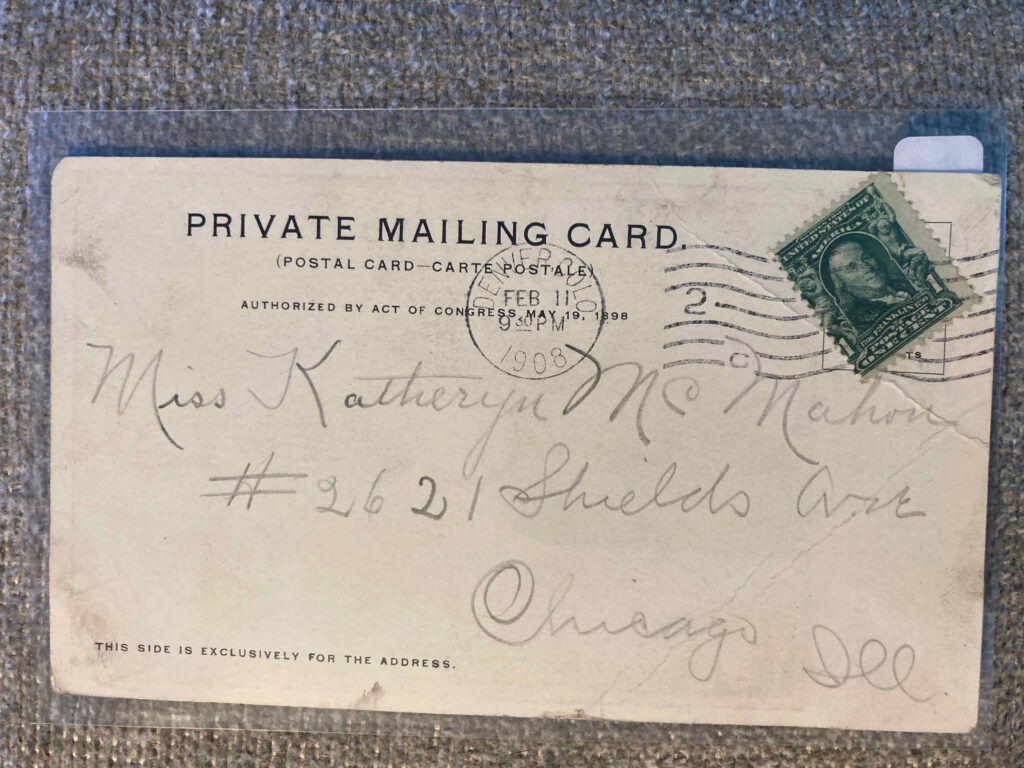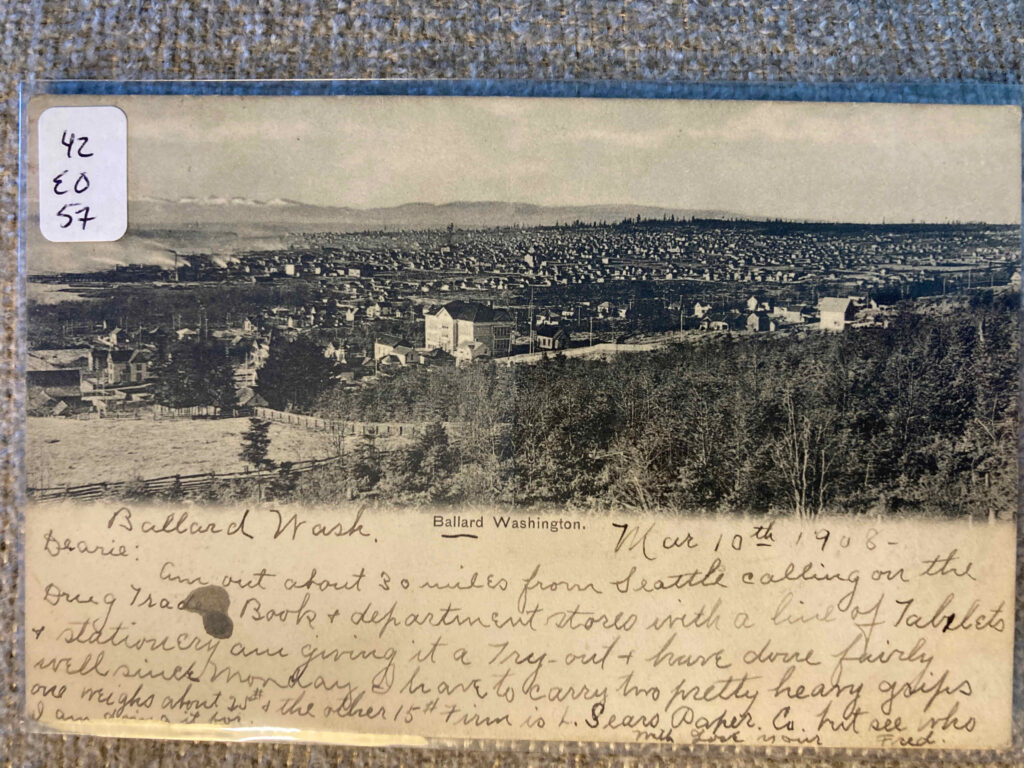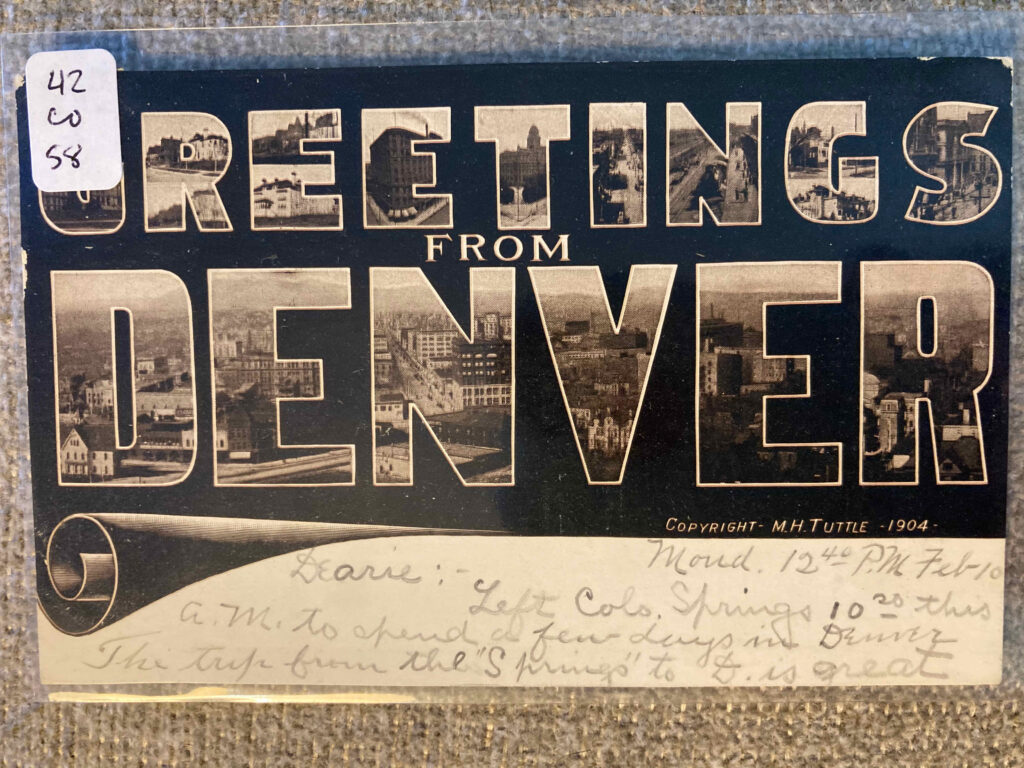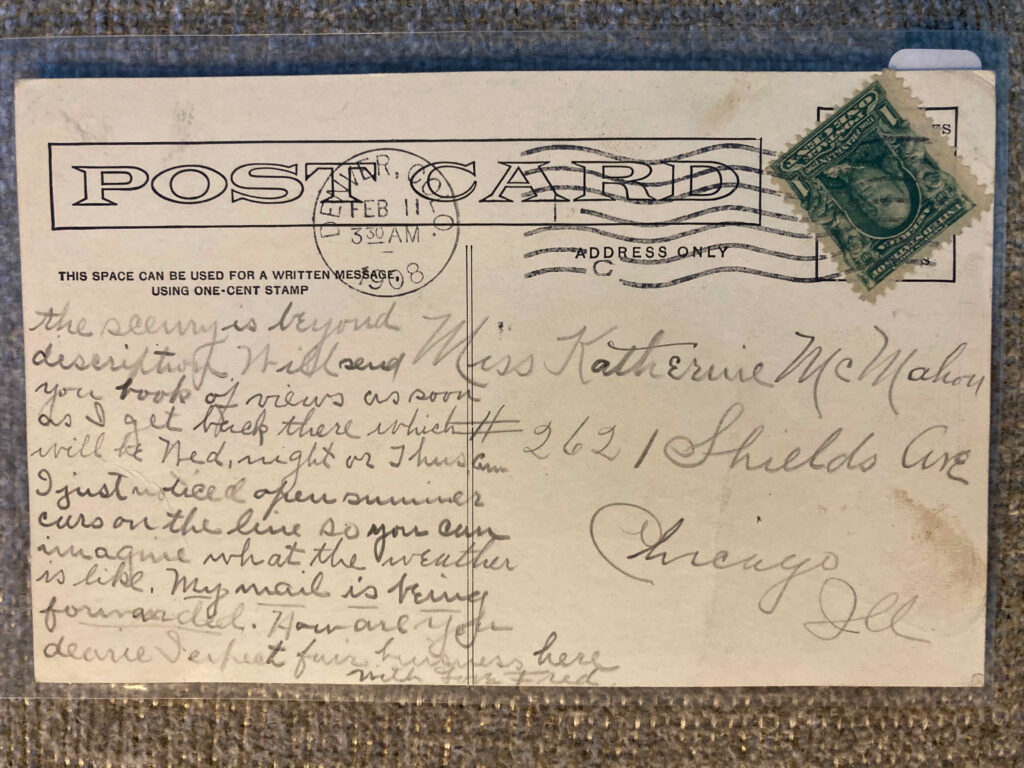Calling on the Drug Trade Book + Department Stores
Katheryn McMahon Newton album, cards 57-59
In which we get more information about what Fred Newton does for a living! As supposed, he’s a salesman. What he sells may vary. He could work for more than one company at any given time, for all we know. However, thanks to the first card shown here we know what he sold, where, and for whom on at least one instance.
The Mr. Sears Fred referred to in other cards is evidently “L. Sears Paper Co.” They produce tablets and stationery, which Fred is selling around Washington–this particular day he went to Ballard and called on a variety of stores. It’s not an easy job, although it is most definitely a white-collar occupation. Quite apart from the actual selling part, he has to lug around samples in two “heavy grips” that he estimates total about 40 lbs. His working for the firm is not, evidently, a done deal for he describes this as “a try-out” albeit without detailing who is trying out whom (is he deciding if he wants the position or Sears determining if Fred’s a good salesman?).
The next card in the album jumps back a month. At this point he’s still probably working as a salesman–why else does he stop at so many places in Colorado on his way to Washington instead of taking a direct route?–but we don’t know what he’s selling. Only that he “expect[s] fair business here.”
Fred manages to squeeze several subjects into this particular card. First and foremost, he’s keeping Katheryn posted as to his whereabouts (left Colorado Springs, arrived safely in Denver). Once again, he lavishes praise on the state for beauteous scenery, which he promises to share with her through a book of views. Implicitly praises the weather by mentioning the “open summer cars on the line”–i.e. even though it’s February (which can be a snowy month in Colorado) there train has out cars suitable for summer travel that are open to allow greater viewing. Last but not least, he makes sure that she knows if she writes to him it will be forwarded and reach him sooner or later (he makes a point to underline that).
Mond. 12:40 P.M. Feb 10 Dearie:– Left Colo Springs 10:20 this A.M. to spend a few days in Denver The trip from the “Springs” to D. is great the scenery is beyond description. Will send you book of views as soon as I get back there which will be Wed. night or Thu am I just noticed open summer cars on the line so you can imagine what the weather is like. My mail is being forwarded. How are you dearie I expect fair business here With love
Fred Newton to Katheryn McMahon, 10 February 1908
Not to overlook the image–note the cutout views spelling out Denver. For some unknown reason, I hadn’t put together that this was a thing in the early 20th century and thus felt some surprise the first time I saw this (or a similar card for another city). Then, on second thought, decided that yes, of course they’d think to do that earlier than I’d expected. Which I’m including here just because no one ever knows everything about any point in the past.
The third card for today dates from even earlier in the trip–sort of. It’s a reminder that the date a card is written is not necessarily the same as the date it’s sent. In this particular case, Fred wrote the card anticipating the train stopping in Elgin, Illinois, which he had evidently visited in company with Katheryn at some point in the past. He dated it 5 February. It’s postmarked six days later–from Denver. It evidently got mixed up with some of his other papers, although he also added a note that the “Train did not stop at Elgin” as reason for the later postmark.
A quick visual note about this particular card. I’m not as familiar with the images (if you’ve made it this far in my blog, you’ve ample evidence I’m focusing more on messages), but this strikes me as a good representation of selective use of color. Many early postcards are hand-colored (especially those requiring subtle nuances of color) and others are mechanically-colored. Whoever designed it or decided how to have it produced decided to use two colors to enhance the black-and-white photo–red and yellow. The red is the more obvious, but I personally admire the layering of yellow around the train car to excellent effect.
This card also has an older design; the reverse describes the card as a “Private Mailing Card” rather than a “Post Card” and refers to the 1898 Act of Congress authorizing cards where only the address can be inscribed there rather than the more recent (as of 1908) cards which allow about half of the back of the card to be used for a message. Perhaps Fred has had it for a while, or wherever he picked it up was selling a mix of old and new (quite understandable since postcards didn’t necessarily go out of date).

“Calling on the Drug Trade Book + Department Stores,” copyright 2021, A.R. Henle.



![Image of a caboose with two women standing at the back rail holding white handkerchiefs. Marked as The Overland Limited, Chicago, Milwaukee, and St. Paul Railway. Fred's message: “Wed. 11A.M. Feb. [?] Dearie—Just getting into Elgin will try to drop this at station if I can How well I remember dearie when we two were last here. With love Fred." Second and third messages: "Hon I just discovered I did not mail this card had it mixed up with some letters F.N. Train did not stop at Elgin”](https://aleahenle.com/wp-content/uploads/2021/01/IMG_5383-768x1024.jpeg)